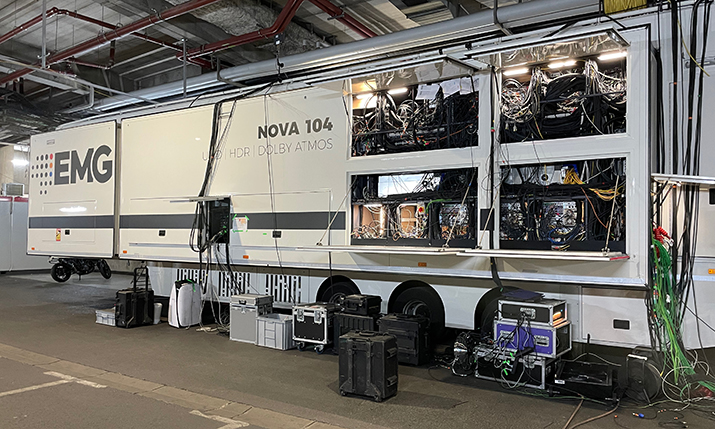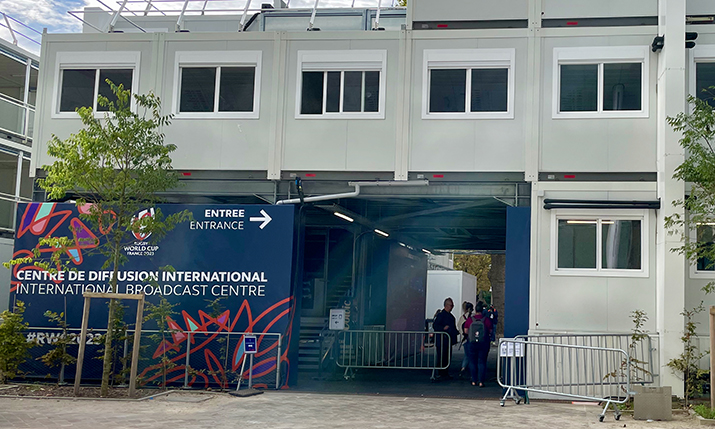Live from the Rugby World Cup 2023: Environmental sustainability underpins all World Rugby and HBS production efforts and decision-making

An EMG outside broadcast unit at the Stade de France during Rugby World Cup 2023
“Everything that we’ve done for this tournament regarding World Rugby’s broadcast operations has been done with environmental sustainability in mind,” says Chris Hope, head of tournament and venue technology at World Rugby. And he’s not wrong.
World Rugby, in conjunction with Host Broadcast Services (HBS), has implemented multiple initiatives to decrease the carbon footprint of the host broadcast operation of its flagship competition. Remote production, 100% biofuel, local crew, a re-purposed International Broadcast Centre (IBC), and the careful scheduling of truck movements have all been put in place with environmental sustainability in mind.
“We’ve tried to do things in a way that limits the amount of travelling that people are doing,” continues Hope. “The beauty about being in France, of course, is the efficient railway system that limits to a minimum our need to fly. As much as possible, we are looking to reduce our carbon footprint.”
The IBC has not been built from scratch. Instead, the buildings and some of the infrastructure that is in place for the host broadcast operation at the French Open tennis at Roland Garros are being used.
Certain match-related activities have been centralised too, such as the ‘Foul Play Review Official’, which is located at the IBC instead of operating at the venues. Centralising the FPRO ensures less travelling is needed for the refereeing teams, who operate from a single base throughout the competition.
Similarly, post-production is handled from a remote facility in London (instead of the IBC, as would have been done previously) with most editing personnel being locally hired.
“The beauty about being in France, of course, is the efficient railway system that limits to a minimum our need to fly. As much as possible, we are looking to reduce our carbon footprint.”
From a rights-holder perspective, World Rugby and HBS have made the production server and the Social Media Interface (SMI) accessible off-site, meaning that there is less need for broadcasters to send their editorial staff on site. The production service and SMI allow broadcasters to download the host broadcast content for linear and digital features.
The really significant change from previous years, however, is the use of 100% biofuel to feed the generators used on broadcast compounds at the match venues.
The biofuel is made of rapeseed oil, a culture that offers several sizeable advantages, such as its minimal water footprint (rapeseed has an innate adaptability to the seasonal rainfall pattern that not only conserves water resources but also reduces the need for artificial irrigation methods), its bio-diversity friendliness (its pollen attracts the bees and its crops serves as a refuge for a diverse array of species), as well as its capacity to reduce soil erosion and prevent monoculture.
During the Rugby World Cup, 100% biofuel is used as the primary fuel for the generators supplying broadcast power and LED boards at all the stadiums, providing a cleaner and more sustainable alternative to traditional fossil fuels. These biofuels generate on average 64% less carbon emissions than traditional fuels.

Bart Lucassen, director of engineering at HBS, acknowledges the focus on the environment.
“This IBC is run on UPS power, for example, so we’re not having running generators here anymore. At the stadiums we’re actually limiting, for example, the running of technical power generators. We only run them on match day minus one and match days. Outside of that, we go back to utility power to feed the technical power distribution. So it stays live.
“We can still monitor it,” he continues, ”but we don’t have any running generators. On match days and match days minus one, we run the generators on the rapeseed biofuel. We had to put some additional effort into making that work because not all generators are capable of handling it. We were specific in selecting these.”
All of the above will help reduce the carbon emissions of Rugby World Cup 2023’s host broadcast operations, thus helping World Rugby reach its target of cutting its carbon emissions by 50% by 2030 as outlined in the international federation’s Environmental Sustainability Plan 2030.
Additionally, Rugby World Cup France 2023 has developed a carbon absorption programme, which aims at offsetting the residual footprint of the event after making every effort to reduce its carbon emissions.
Media carbon footprint is estimated at 3,054 tons of CO2 equivalent, with a vast majority coming from air travel. World Rugby has contributed to France 2023’s programme restoring mangroves to absorb all Accredited Media’s emissions of travelling to France.
It’s an impressive effort by all concerned and shows how attitudes towards sustainability have changed, although there is one unfortunate lighthearted side effect of using 100% biofuel, says Lucassen.
“The only downside now, at the compound, when you run generators on rapeseed oil, it smells like French fries! Everyone is hungry.”
The 2023 Rugby World Cup continues in France until Saturday 28 October.
Read more:
- Live from the Rugby World Cup 2023: World Rugby and HBS offer up additional content for rights-holding broadcasters
- Live from the Rugby World Cup 2023: Consistency and simplicity are key for host broadcast match coverage
- Live from the Rugby World Cup 2023: Referee mic plays crucial role in capturing atmosphere and ambience
- Live from the Rugby World Cup 2023: Digital content production offering proves popular with broadcasters and ‘TikTok Generation’ alike

